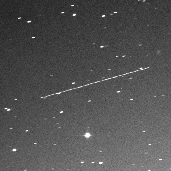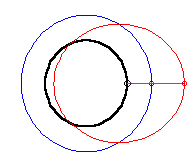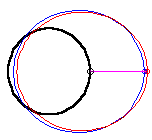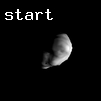
 Discovering
an asteroid is only the first step.
Discovering
an asteroid is only the first step.  Next
you've got to figure out its orbit so you know where it will be in the
future. Otherwise it'll get lost. Physics tells us that an
orbiting object moves along an ellipse. Orbit determination involves figuring
out which ellipse from observing the angle between the asteroid
and other objects in the sky. These two figures illustrate the idea.
The black orbit represents Earth. Suppose that the blue curve is your guess
at an asteroid's orbit while the true orbit is the red one. You would
expect to see the asteroid in the direction of the light blue line, but
it will show up along the direction of the magenta line. If your
guess isn't very good, like in the figure at top left, these two directions
will not agree very well. Say you improve your estimate to get the
situation in the figure at top right. Now the agreement is quite a bit
better, but still not perfect. So, you can improve your estimate
some more, and so on. In this manner orbits can be determined with
enough accuracy to allow us to accurately predict where an asteroid will
be hundreds of years from now.
Next
you've got to figure out its orbit so you know where it will be in the
future. Otherwise it'll get lost. Physics tells us that an
orbiting object moves along an ellipse. Orbit determination involves figuring
out which ellipse from observing the angle between the asteroid
and other objects in the sky. These two figures illustrate the idea.
The black orbit represents Earth. Suppose that the blue curve is your guess
at an asteroid's orbit while the true orbit is the red one. You would
expect to see the asteroid in the direction of the light blue line, but
it will show up along the direction of the magenta line. If your
guess isn't very good, like in the figure at top left, these two directions
will not agree very well. Say you improve your estimate to get the
situation in the figure at top right. Now the agreement is quite a bit
better, but still not perfect. So, you can improve your estimate
some more, and so on. In this manner orbits can be determined with
enough accuracy to allow us to accurately predict where an asteroid will
be hundreds of years from now.
For example consider the model
of asteroid Geographos shown here.  As it rotates we can sometimes see a lot of its surface while at other
times we only see a little. So the solid curve at right, which is the plot
of total brightness vs. time, goes up and down. Graphs of this
sort are called light curves. The circles plotted are the actual
Geographos brightness measurements made by astronomers.
As it rotates we can sometimes see a lot of its surface while at other
times we only see a little. So the solid curve at right, which is the plot
of total brightness vs. time, goes up and down. Graphs of this
sort are called light curves. The circles plotted are the actual
Geographos brightness measurements made by astronomers. |
 |
The time it takes for a lightcurve to start repeating is the length of the asteroid's day, called its rotation period. The lightcurve amplitude (how much the curve goes up and down) gives us some information about the elongation of the asteroid - in other words, it tells us something about how stretched out into a cigar shape the asteroid is. The lightcurve of a sphere would not go up and down at all, so any lightcurve variations immediately tell us that the asteroid is non-spherical and/or possibily has surface features.